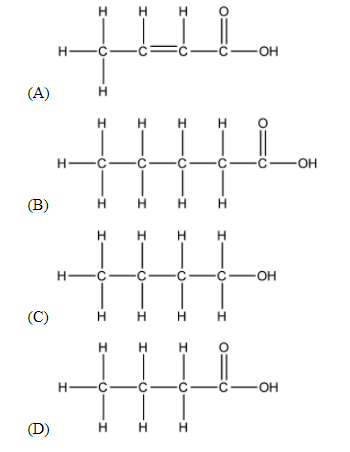
The correct structural formula of butanoic acid is:

Answer
142.2k+ views
Hint: The term ‘-oic acid’ suffix suggests the presence of a carboxylic acid functional group in the organic compound but prefix suggests the presence of four carbons in the compound.
Complete step by step answer:
Let’s get familiar about nomenclature.In general, an IUPAC name always has three essential features:
i) A root or base indicating a major chain or ring of carbon atoms found in the molecular structure.
ii) A suffix or other element(s) which represents the functional groups that may be present in the compound.
iii) Names of substituent groups, other than hydrogen, that complete the molecular structure.
With these rules in mind, let us now analyse the name ‘butanoic acid’.
The prefix ‘but-’ means that the longest Carbon chain of the required structure contains 4 Carbon atoms. Thus, we can easily eliminate (B) as a possible answer.
As the suffix ‘-oic acid’ suggests, the functional group of the compound is carboxylic acid. Carboxylic acid can be shown as –COOH. This further narrows our possible answers down to (A) and (D).
The middle part of the name ‘-an-’ suggests that there are no unsaturated bonds in the longest Carbon chain, thus we can eliminate option (A) as an answer. Thus, we can safely conclude that the answer to this question is (D).
Thus, the answer to the above question is option (D).
Note: Here, we are given only ‘butanoic acid’ as the name of the compound, so terminal carbon will be of carboxylic acid functional group. When any specific number is given before the name of the compound (i.e. 2-butanoic acid), then it will suggest the position of the carboxylic acid functional group and we will then have to choose the structure accordingly.
Complete step by step answer:
Let’s get familiar about nomenclature.In general, an IUPAC name always has three essential features:
i) A root or base indicating a major chain or ring of carbon atoms found in the molecular structure.
ii) A suffix or other element(s) which represents the functional groups that may be present in the compound.
iii) Names of substituent groups, other than hydrogen, that complete the molecular structure.
With these rules in mind, let us now analyse the name ‘butanoic acid’.
The prefix ‘but-’ means that the longest Carbon chain of the required structure contains 4 Carbon atoms. Thus, we can easily eliminate (B) as a possible answer.
As the suffix ‘-oic acid’ suggests, the functional group of the compound is carboxylic acid. Carboxylic acid can be shown as –COOH. This further narrows our possible answers down to (A) and (D).
The middle part of the name ‘-an-’ suggests that there are no unsaturated bonds in the longest Carbon chain, thus we can eliminate option (A) as an answer. Thus, we can safely conclude that the answer to this question is (D).
Thus, the answer to the above question is option (D).
Note: Here, we are given only ‘butanoic acid’ as the name of the compound, so terminal carbon will be of carboxylic acid functional group. When any specific number is given before the name of the compound (i.e. 2-butanoic acid), then it will suggest the position of the carboxylic acid functional group and we will then have to choose the structure accordingly.
Recently Updated Pages
Classification of Drugs Based on Pharmacological Effect, Drug Action

Difference Between Alcohol and Phenol

JEE Main Participating Colleges 2024 - A Complete List of Top Colleges

JEE Main Maths Paper Pattern 2025 – Marking, Sections & Tips

Sign up for JEE Main 2025 Live Classes - Vedantu

JEE Main 2025 Helpline Numbers - Center Contact, Phone Number, Address

Trending doubts
JEE Main 2025 Session 2: Application Form (Out), Exam Dates (Released), Eligibility, & More

JEE Main Exam Marking Scheme: Detailed Breakdown of Marks and Negative Marking

JEE Main 2025: Derivation of Equation of Trajectory in Physics

Electric Field Due to Uniformly Charged Ring for JEE Main 2025 - Formula and Derivation

Types of Solutions

Learn About Angle Of Deviation In Prism: JEE Main Physics 2025

Other Pages
NCERT Solutions for Class 12 Chemistry Chapter 6 Haloalkanes and Haloarenes

NCERT Solutions for Class 12 Chemistry Chapter 2 Electrochemistry

NCERT Solutions for Class 12 Chemistry Chapter 7 Alcohol Phenol and Ether

NCERT Solutions for Class 12 Chemistry Chapter 1 Solutions

Solutions Class 12 Notes: CBSE Chemistry Chapter 1

JEE Advanced Marks vs Ranks 2025: Understanding Category-wise Qualifying Marks and Previous Year Cut-offs




